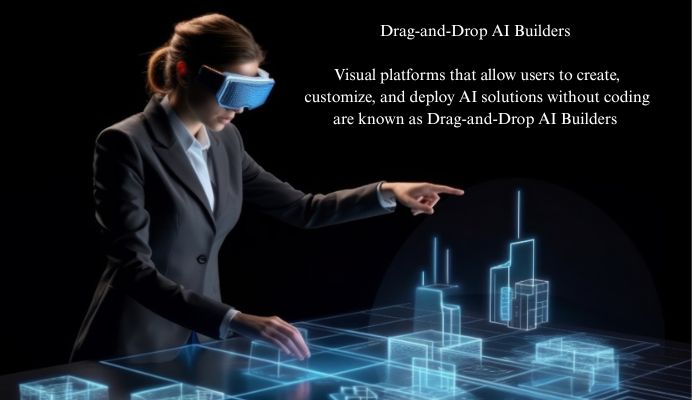
Drag-and-Drop AI Builders: Simplifying Smart Factory Automation
Introduction
The next industrial revolution is here, and it’s being powered by artificial intelligence. In modern manufacturing, smart factories are no longer futuristic concepts; they’re rapidly becoming the standard. By integrating automation, connected sensors, and machine learning, manufacturers are finding new ways to reduce downtime, optimize energy use, and maintain impeccable product quality.
But while the possibilities of AI-driven factories are exciting, the path to implementation has often come with steep barriers. Traditionally, deploying AI solutions required advanced coding skills, specialized data science expertise, and heavy investments of time and money.
Enter drag-and-drop AI builders: intuitive platforms that are changing the game. By allowing anyone to create, customize, and deploy AI solutions through simple visual interfaces, these tools remove the complexity of coding from the equation. Think of them as the “easy button” for factory automation—empowering plant managers, engineers, and operators to directly harness AI for smarter, faster decision-making.
The challenges of AI adoption in manufacturing
The challenges of AI adoption in manufacturing include the following
1. Complexity of traditional AI development
Building and deploying AI solutions historically requires highly specialized expertise. Data scientists, AI researchers, and software engineers work together to collect, clean, and label data, train deep learning models, tune algorithms, and integrate them into existing systems.
For many factories, this level of technical complexity represents a steep learning curve that their in-house teams may struggle to handle.
2. High costs and long timelines
Developing a custom AI solution from scratch can take months, sometimes years, before it delivers measurable results. Add to that the costs of infrastructure, software licenses, and skilled professionals, and the barrier becomes even higher. For small and medium-sized manufacturers with limited budgets, these costs often make AI feel like an unattainable luxury rather than an achievable investment.
3. Skill gap in the workforce
Even when companies are willing to invest, they face another issue: the global shortage of AI talent. Manufacturing plants are filled with brilliant engineers, technicians, and operators, but few have the deep coding or data science skills required for traditional AI development. This mismatch in skills creates a dependency on external vendors or consultants, which can further increase costs and slow down innovation.
4. Integration with legacy systems
Factories are often a mixture of advanced technologies and decades-old machinery. Integrating AI into this environment isn’t as simple as “plug and play.” Legacy equipment may not generate clean data or may lack connectivity, requiring additional upgrades or complex middleware solutions to work with modern AI platforms. This integration gap adds time, expense, and risk to deployment.
5. Data quality and availability
AI thrives on high-quality, well-structured data. Unfortunately, many manufacturing environments produce fragmented, inconsistent, or siloed data across different machines and production lines. Without reliable data pipelines, even the most sophisticated AI models deliver poor results, leading to frustration and skepticism about AI’s true value.
What are drag-and-drop AI builders?
Drag-and-drop AI builders are intuitive, visual platforms that allow users to create, customize, and deploy artificial intelligence solutions without needing to write any code.
Instead of programming from scratch, users assemble AI components and workflows by dragging and dropping pre-built blocks such as data inputs, model logic, and output elements onto a visual canvas.
This approach dramatically simplifies AI development, making it accessible to non-technical users like engineers, plant managers, and operators.
How to simplify smart factory automation?
Smart factory automation involves integrating complex systems, data streams, and AI insights to optimize manufacturing operations—from predictive maintenance and quality control to energy management and supply chain coordination.
Traditionally, building these AI-powered automation solutions required extensive coding, technical expertise, and long development cycles, creating significant hurdles for many manufacturers.
Drag-and-drop AI builders simplify this process by turning AI development into an accessible, visual experience that anyone in the factory can use.
Here’s how they make smart factory automation easier:
- Lowering Technical Barriers: By replacing complex code with intuitive visual components, drag-and-drop platforms empower engineers, plant managers, and operators, regardless of their AI or programming background, to design automation workflows tailored to their unique production challenges.
- Seamless IoT and System Integration: These platforms come built to connect with industrial IoT devices, robots, and legacy manufacturing equipment, ensuring smooth data flow and enabling real-time AI-driven decision-making without complicated middleware or custom coding.
- Rapid Prototyping and Deployment: Users can quickly assemble AI-powered automation solutions by configuring predefined modules such as sensor data collection, anomaly detection, and automated alert systems. This speeds up experimentation and implementation, enabling factories to achieve faster time-to-value.
- Use Case Flexibility: Whether it’s predictive maintenance to anticipate machine failures, computer vision systems for quality inspections, energy consumption optimization, or managing inventory and supply chains, drag-and-drop AI builders provide versatile tools that fit a wide range of smart factory automation needs.
- Continuous Iteration and Improvement: Visual workflows make it easy to adjust AI models and automation processes based on real-time factory insights, allowing ongoing refinement without the need for extensive redevelopment.
Key benefits of drag-and-drop AI builders
Drag-and-drop AI builders bring significant benefits that transform how manufacturers approach AI and automation. These advantages combine to make smart factory initiatives more practical, efficient, and widely accessible:
1. Speed: Rapid prototyping and deployment
Traditional AI projects often require months of development, coding, and testing. Drag-and-drop AI builders dramatically reduce this timeline by enabling users to assemble and deploy AI models through visual workflows quickly.
This speed allows factories to respond faster to production challenges, test multiple solutions, and achieve quicker returns on their AI investments.
2. Accessibility: Democratizing AI for Non-Technical Users
Not every factory has a team of AI experts or skilled programmers. Drag-and-drop platforms empower engineers, technicians, and plant managers who deeply understand the manufacturing process but may lack coding expertise to build and customize AI solutions themselves. This democratization opens AI innovation to a broader audience within the organization.
3. Cost-Effectiveness: Lowering AI implementation costs
By reducing dependency on expensive data scientists and developers, these platforms cut the cost barriers traditionally associated with AI adoption. Faster development cycles also mean less downtime and fewer external consulting fees. Manufacturers can allocate resources more efficiently and scale automation projects without ballooning costs.
4. Scalability: Easy Replication Across Multiple Locations
Once proven on one production line or factory floor, drag-and-drop AI solutions can be duplicated and adapted quickly across multiple plants or facilities. Visual workflows simplify knowledge transfer and standardize processes, supporting consistent quality and performance at scale.
5. Flexibility: Simple Iteration and Adaptability
Manufacturing environments are dynamic, with frequent changes in products, regulations, and technology. Drag-and-drop AI builders allow non-technical users to easily tweak models, inputs, and workflows in real time without needing extensive redevelopment. This flexibility ensures AI-driven automation stays aligned with evolving factory needs.
The Future of AI Builders in Smart Manufacturing
As smart manufacturing evolves, the role of AI builders—especially drag-and-drop and low-code/no-code platforms—will become increasingly pivotal in shaping the factories of tomorrow.
These AI tools are not only transforming how automation is developed and deployed today, but they also promise to drive the next wave of innovation in Industry 5.0 and beyond.
1. Advancing towards Industry 5.0: Human Machine Collaboration
While Industry 4.0 focused on automation and connectivity, Industry 5.0 brings human creativity and decision-making back to the forefront, partnering workers closely with intelligent machines.
AI builders will play a crucial role in this transition by enabling factory personnel to easily create and customize AI tools that augment their expertise rather than replace it. This collaboration will foster safer, more flexible manufacturing environments where humans and AI work together harmoniously.
2. Edge AI integration for Real-time decision making
Future AI builders will increasingly support deployment not only in the cloud but directly at the edge—on factory floors and individual machines. Edge AI minimizes latency by processing data locally, enabling instantaneous responses critical for time-sensitive tasks like machine control and defect detection. Drag-and-drop platforms will evolve to facilitate edge deployment seamlessly, making real-time, AI-driven automation a standard feature of smart factories.
3. Deeper integration with Robotics, AR/VR, and Digital Twins
AI builders will expand their capabilities to integrate with other emerging technologies crucial to smart manufacturing:
- Robotics: Simplified AI workflows will directly control robots, enabling more adaptive, intelligent automation.
- Augmented Reality (AR) and Virtual Reality (VR): AI-powered AR/VR solutions will assist operators with real-time data visualization and remote support, and AI builders will enable faster creation of these immersive experiences.
- Digital Twins: AI builders will make it easier to create and maintain digital twins—virtual replicas of physical assets—using AI models for simulation, predictive analytics, and optimization.
4. Growing ecosystems and collaborative innovation
The future will see expanding ecosystems where manufacturers, software developers, and AI experts share components, models, and best practices.
Drag-and-drop AI builders will support marketplace-style environments, allowing factories to access, customize, and deploy AI modules developed by others, accelerating innovation especially for small and medium enterprises (SMEs). This openness will democratize AI even further, fostering a community-driven approach to automation.
5. Increased focus on explainability and trust
As AI takes on more critical manufacturing roles, transparency and trust become paramount. Future AI builders will include enhanced explainability features that help users understand how AI models make decisions and identify potential biases or errors. This will be vital for regulatory compliance, safety, and operator confidence, ensuring AI adoption is responsible and sustainable.
6. AI builders empowering sustainability and resilient manufacturing
With growing emphasis on sustainability, AI builders will facilitate automation solutions that optimize energy consumption, reduce waste, and improve resource management. By simplifying AI deployment, manufacturers can rapidly adapt operations to meet environmental goals and enhance resilience against supply chain disruptions or market shifts.
Conclusion
Drag-and-drop AI builders are revolutionizing the way manufacturers approach smart factory automation. By breaking down complex AI development into accessible visual workflows, these platforms empower a wide range of factory personnel to harness the power of artificial intelligence without the need for coding expertise. This democratization of AI accelerates innovation, reduces costs, and makes the benefits of Industry 4.0 attainable for manufacturers of all sizes.
As smart factories continue to evolve, drag-and-drop AI builders will play an even more critical role in enabling rapid adaptation, fostering human-machine collaboration, and integrating seamlessly with emerging technologies like edge computing, robotics, and digital twins.
By simplifying AI adoption, these tools are helping to unlock the full potential of smart manufacturing, driving greater efficiency, sustainability, and resilience in an ever-changing industrial landscape.






